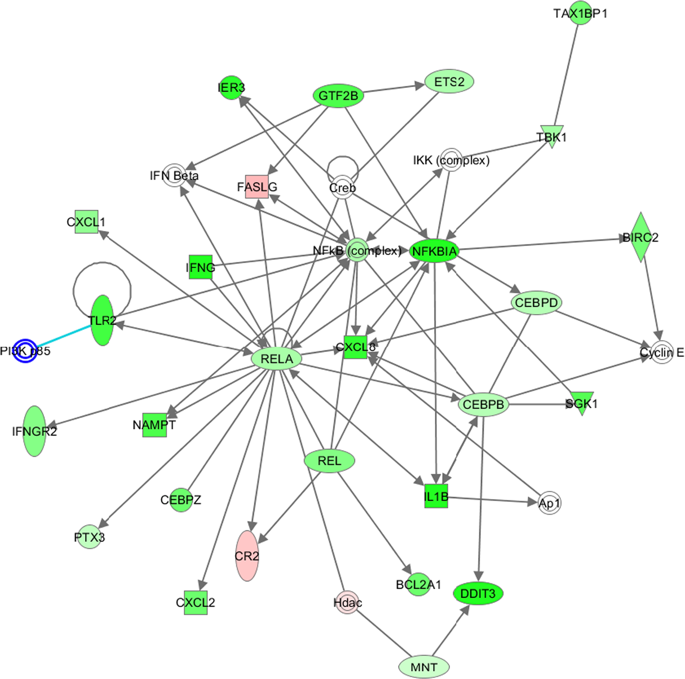当前位置:
X-MOL 学术
›
Pharmacogenomics J.
›
论文详情
Our official English website, www.x-mol.net, welcomes your feedback! (Note: you will need to create a separate account there.)
Genome-wide transcriptomics leads to the identification of deregulated genes after deferasirox therapy in low-risk MDS patients.
The Pharmacogenomics Journal ( IF 2.8 ) Pub Date : 2020-02-04 , DOI: 10.1038/s41397-020-0154-5 Jesús María Hernández Sánchez 1 , Eva Lumbreras 1 , María Díez-Campelo 2 , Teresa González 1, 2 , Diego Alonso López 3 , María Abáigar 1 , Mónica Del Rey 1 , Ana África Martín 2 , Raquel de Paz 4 , Sara Erquiaga 5 , Beatriz Arrizabalaga 5 , Jesús María Hernández-Rivas 1, 2 , Ana Eugenia Rodríguez Vicente 1
The Pharmacogenomics Journal ( IF 2.8 ) Pub Date : 2020-02-04 , DOI: 10.1038/s41397-020-0154-5 Jesús María Hernández Sánchez 1 , Eva Lumbreras 1 , María Díez-Campelo 2 , Teresa González 1, 2 , Diego Alonso López 3 , María Abáigar 1 , Mónica Del Rey 1 , Ana África Martín 2 , Raquel de Paz 4 , Sara Erquiaga 5 , Beatriz Arrizabalaga 5 , Jesús María Hernández-Rivas 1, 2 , Ana Eugenia Rodríguez Vicente 1
Affiliation

|
The iron chelator deferasirox is widely used in patients with iron overload. Patients with low-grade myelodysplastic syndromes (MDS) get transfusion dependency and need to be treated with deferasirox to avoid iron overload. Moreover, in some patients an increase in both erythroid and platelets have been observed after deferasirox therapy. However, the mechanisms involved in these clinical findings are poorly understood. The aim of this work was to analyze, in patients treated with deferasirox, the changes in the gene-expression profile after receiving the treatment. A total of 15 patients with the diagnosis of low-grade MDS were studied. Microarrays were carried out in RNA from peripheral blood before and after 14 weeks of deferasirox therapy. Changes in 1457 genes and 54 miRNAs were observed: deferasirox induced the downregulation of genes related to the Nf kB pathway leading of an overall inactivation of this pathway. In addition, the iron chelator also downregulated gamma interferon. Altogether these changes could be related to the improvement of erythroid response observed in these patients after therapy. Moreover, the inhibition of NFE2L2/NRF2, which was predicted in silico, could be playing a critical role in the reduction of reactive oxygen species (ROS). Of note, miR-125b, overexpressed after deferasirox treatment, could be involved in the reduced inflammation and increased hematopoiesis observed in the patients after treatment. In summary this study shows, for the first time, the mechanisms that could be governing deferasirox impact in vivo.
中文翻译:

全基因组转录组学可在低风险MDS患者中接受Deferasirox治疗后鉴定失调的基因。
铁螯合剂地拉罗司广泛用于铁超负荷患者。患有低级骨髓增生异常综合症(MDS)的患者会出现输血依赖性,需要用地拉罗司治疗以避免铁超负荷。此外,在一些患者中,地拉罗司治疗后观察到红系和血小板均增加。但是,这些临床发现所涉及的机制了解甚少。这项工作的目的是分析接受地拉罗司治疗的患者接受治疗后基因表达谱的变化。共研究了15例诊断为低级MDS的患者。在地拉罗司治疗14周之前和之后,在来自外周血的RNA中进行微阵列。观察到1457个基因和54个miRNA的变化:Deferasirox诱导了与Nf kB途径相关的基因的下调,导致该途径整体失活。此外,铁螯合剂还下调了γ干扰素。总的来说,这些变化可能与这些患者在治疗后观察到的类红细胞反应的改善有关。此外,在计算机模拟中预测的NFE2L2 / NRF2抑制作用可能在减少活性氧(ROS)方面起关键作用。值得注意的是,地拉罗司治疗后过表达的miR-125b可能与治疗后患者炎症减少和造血功能增加有关。总而言之,这项研究首次显示了可能在体内控制地拉罗司影响的机制。铁螯合剂也下调了γ干扰素。总的来说,这些变化可能与这些患者在治疗后观察到的类红细胞反应的改善有关。此外,在计算机模拟中预测的NFE2L2 / NRF2抑制作用可能在减少活性氧(ROS)方面起关键作用。值得注意的是,地拉罗司治疗后过表达的miR-125b可能与治疗后患者炎症减少和造血功能增加有关。总而言之,这项研究首次显示了可能在体内控制地拉罗司影响的机制。铁螯合剂也下调了γ干扰素。总的来说,这些变化可能与这些患者在治疗后观察到的类红细胞反应的改善有关。此外,在计算机模拟中预测的NFE2L2 / NRF2抑制作用可能在减少活性氧(ROS)方面起关键作用。值得注意的是,地拉罗司治疗后过表达的miR-125b可能与治疗后患者炎症减少和造血功能增加有关。总而言之,这项研究首次显示了可能在体内控制地拉罗司影响的机制。在计算机上进行了预测,它可能在减少活性氧(ROS)方面起关键作用。值得注意的是,地拉罗司治疗后过表达的miR-125b可能与治疗后患者炎症减少和造血功能增加有关。总而言之,这项研究首次显示了可能在体内控制地拉罗司影响的机制。在计算机上进行了预测,它可能在减少活性氧(ROS)方面起关键作用。值得注意的是,地拉罗司治疗后过表达的miR-125b可能与治疗后患者炎症减少和造血功能增加有关。总而言之,这项研究首次显示了可能在体内控制地拉罗司影响的机制。
更新日期:2020-02-04
中文翻译:

全基因组转录组学可在低风险MDS患者中接受Deferasirox治疗后鉴定失调的基因。
铁螯合剂地拉罗司广泛用于铁超负荷患者。患有低级骨髓增生异常综合症(MDS)的患者会出现输血依赖性,需要用地拉罗司治疗以避免铁超负荷。此外,在一些患者中,地拉罗司治疗后观察到红系和血小板均增加。但是,这些临床发现所涉及的机制了解甚少。这项工作的目的是分析接受地拉罗司治疗的患者接受治疗后基因表达谱的变化。共研究了15例诊断为低级MDS的患者。在地拉罗司治疗14周之前和之后,在来自外周血的RNA中进行微阵列。观察到1457个基因和54个miRNA的变化:Deferasirox诱导了与Nf kB途径相关的基因的下调,导致该途径整体失活。此外,铁螯合剂还下调了γ干扰素。总的来说,这些变化可能与这些患者在治疗后观察到的类红细胞反应的改善有关。此外,在计算机模拟中预测的NFE2L2 / NRF2抑制作用可能在减少活性氧(ROS)方面起关键作用。值得注意的是,地拉罗司治疗后过表达的miR-125b可能与治疗后患者炎症减少和造血功能增加有关。总而言之,这项研究首次显示了可能在体内控制地拉罗司影响的机制。铁螯合剂也下调了γ干扰素。总的来说,这些变化可能与这些患者在治疗后观察到的类红细胞反应的改善有关。此外,在计算机模拟中预测的NFE2L2 / NRF2抑制作用可能在减少活性氧(ROS)方面起关键作用。值得注意的是,地拉罗司治疗后过表达的miR-125b可能与治疗后患者炎症减少和造血功能增加有关。总而言之,这项研究首次显示了可能在体内控制地拉罗司影响的机制。铁螯合剂也下调了γ干扰素。总的来说,这些变化可能与这些患者在治疗后观察到的类红细胞反应的改善有关。此外,在计算机模拟中预测的NFE2L2 / NRF2抑制作用可能在减少活性氧(ROS)方面起关键作用。值得注意的是,地拉罗司治疗后过表达的miR-125b可能与治疗后患者炎症减少和造血功能增加有关。总而言之,这项研究首次显示了可能在体内控制地拉罗司影响的机制。在计算机上进行了预测,它可能在减少活性氧(ROS)方面起关键作用。值得注意的是,地拉罗司治疗后过表达的miR-125b可能与治疗后患者炎症减少和造血功能增加有关。总而言之,这项研究首次显示了可能在体内控制地拉罗司影响的机制。在计算机上进行了预测,它可能在减少活性氧(ROS)方面起关键作用。值得注意的是,地拉罗司治疗后过表达的miR-125b可能与治疗后患者炎症减少和造血功能增加有关。总而言之,这项研究首次显示了可能在体内控制地拉罗司影响的机制。



























 京公网安备 11010802027423号
京公网安备 11010802027423号